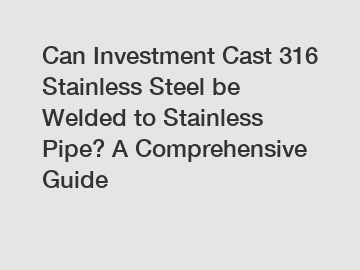Can Investment Cast 316 Stainless Steel be Welded to Stainless Pipe? A Comprehensive Guide
Investment casting is a popular method for creating complex and intricately detailed parts, especially when it comes to stainless steel. And when it comes to welding investment cast 316 stainless steel to stainless pipe, there are a few key considerations to keep in mind. In this comprehensive guide, we will explore the ins and outs of welding these two materials together, offering valuable insights and expert advice along the way.
First and foremost, it's important to understand the properties of 316 stainless steel. This grade of stainless steel is highly corrosion-resistant, making it ideal for applications where exposure to harsh environments is a concern. It also offers excellent strength and durability, making it a popular choice for a wide range of industries and applications.
When it comes to welding 316 stainless steel to stainless pipe, there are several factors that must be taken into consideration. One of the most important considerations is the type of welding process that will be used. In general, both TIG (tungsten inert gas) and MIG (metal inert gas) welding processes are suitable for welding stainless steel.

TIG welding is a popular choice for welding stainless steel due to its high degree of precision and control. This process involves using a tungsten electrode to create a spark that melts the two pieces of metal together, forming a strong and durable bond. TIG welding is commonly used for welding thin materials, such as stainless steel pipes, where precision and control are crucial.
On the other hand, MIG welding is another popular choice for welding stainless steel. This process involves using a wire feed to create a spark that melts the two pieces of metal together. MIG welding is ideal for welding thicker materials, as it offers a higher deposition rate and faster welding speed compared to TIG welding.
Regardless of the welding process used, it is important to ensure that the proper welding techniques and equipment are used when welding investment cast 316 stainless steel to stainless pipe. This includes using the correct filler material, shielding gas, and welding parameters to ensure a strong and durable weld.
Another important consideration when welding stainless steel is the potential for distortion and warping during the welding process. Stainless steel has a high coefficient of thermal expansion, which means that it can expand and contract significantly when exposed to high temperatures. This can result in distortion and warping of the welded parts if proper precautions are not taken.
To minimize distortion and warping when welding investment cast 316 stainless steel to stainless pipe, it is important to preheat the materials before welding and to use proper welding techniques, such as back purging and tack welding. Preheating the materials helps to reduce the temperature differential between the base metal and the weld metal, which can minimize distortion and warping. Back purging involves using an inert gas, such as argon, to shield the back side of the weld from oxidation and contamination, which can help to improve the quality of the weld. Tack welding involves creating small welds along the seam before completing the final weld, which helps to stabilize the materials and reduce the risk of distortion and warping.
In addition to proper welding techniques, it is also important to consider the post-weld heat treatment of the welded parts. Heat treatment can help to relieve residual stresses in the weld and improve the mechanical properties of the welded joint. This can help to ensure a strong and durable weld that will stand up to the rigors of the intended application.
In conclusion, welding investment cast 316 stainless steel to stainless pipe is certainly possible with the right techniques and equipment. By understanding the properties of stainless steel, choosing the right welding process, using proper welding techniques, and considering post-weld heat treatment, you can achieve a strong and durable weld that meets the requirements of your application. With the guidance and expertise of a skilled welder, you can ensure a successful welding process that will result in a high-quality finished product.
If you want to learn more, please visit our website Camlock Handle Ring, Stainless Steel Camlock Quick Connector, Customized Precision Castings.
35
0
0


Comments
All Comments (0)